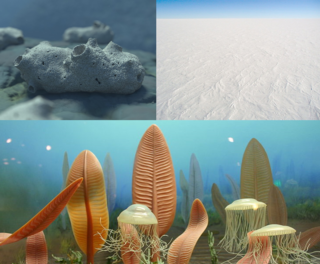Related Research Articles

The Neoproterozoic Era is the unit of geologic time from 1 billion to 538.8 million years ago.
In the geologic timescale, the Valanginian is an age or stage of the Early or Lower Cretaceous. It spans between 139.8 ± 3.0 Ma and 132.6 ± 2.0 Ma. The Valanginian Stage succeeds the Berriasian Stage of the Lower Cretaceous and precedes the Hauterivian Stage of the Lower Cretaceous.
Albansia is an extinct genus from a well-known class of fossil marine arthropods, the trilobites. It lived during the Cambrian Period, which lasted from approximately 539 to 485 million years ago.
Balderia is an extinct genus from a well-known class of fossil marine arthropods, the trilobites. It lived during the Cambrian Period, which lasted from approximately 539 to 485 million years ago.
Chondroparia is an extinct genus from a well-known class of fossil marine arthropods, the trilobites. It lived during the Cambrian Period, which lasted from approximately 539 to 485 million years ago.
Conopolus is an extinct genus from a well-known class of fossil marine arthropods, the trilobites. It lived during the Cambrian Period, which lasted from approximately 539 to 485 million years ago.
Durinia is an extinct genus from a well-known class of fossil marine arthropods, the trilobites. It lived during the Cambrian Period, which lasted from approximately 539 to 485 million years ago.
Girandia is an extinct genus from a well-known class of fossil marine arthropods, the trilobites. It lived during the Cambrian Period, which lasted from approximately 539 to 485 million years ago.
Liopelta is an extinct genus from a well-known class of fossil marine arthropods, the trilobites. It lived during the Cambrian Period, which lasted from approximately 539 to 485 million years ago.
Hatangia is an extinct genus from a well-known class of fossil marine arthropods, the trilobites. It lived during the Cambrian Period, which lasted from approximately 539 to 485 million years ago in Siberia.
Lydiaspis is an extinct genus from a well-known class of fossil marine arthropods, the trilobites. It lived during the Cambrian Period, which lasted from approximately 539 to 485 million years ago.
Wandelella is an extinct genus from a well-known class of fossil marine arthropods, the trilobites. It lived during the Cambrian Period, which lasted from approximately 539 to 485 million years ago.
Tosotychia is an extinct genus from a well-known class of fossil marine arthropods, the trilobites. It lived during the Cambrian Period, which lasted from approximately 539 to 485 million years ago.
Rawlinsella is an extinct genus from a well-known class of fossil marine arthropods, the trilobites. It lived during the Cambrian Period, which lasted from approximately 539 to 485 million years ago.
Quitalia is an extinct genus from a well-known class of fossil marine arthropods, the trilobites. It lived during the Cambrian Period, which lasted from approximately 539 to 485 million years ago.
Oculeus is an extinct genus from a well-known class of fossil marine arthropods, the trilobites. It lived during the Cambrian Period, which lasted from approximately 539 to 485 million years ago.
Schoriella is an extinct genus of trilobites in the family Anomocaridae. The genus lived during the Cambrian Period, which lasted from approximately 539 to 485 million years ago.

The Fox Hills Formation is a Cretaceous geologic formation in the northwestern Great Plains of North America. It is present from Alberta on the north to Colorado in the south.

Leyvachelys is an extinct genus of turtles in the family Sandownidae from the Early Cretaceous of the present-day Altiplano Cundiboyacense, Eastern Ranges, Colombian Andes. The genus is known only from its type species, Leyvachelys cipadi, described in 2015 by Colombian paleontologist Edwin Cadena. Fossils of Leyvachelys have been found in the fossiliferous Paja Formation, close to Villa de Leyva, Boyacá, after which the genus is named. The holotype specimen is the oldest and most complete sandownid turtle found to date.

The Ganigobis Formation is a Late Carboniferous (Gzhelian) to Early Permian (Artinskian) geologic formation of the Dwyka Group in the ǁKaras Region of southeastern Namibia and the Northern Cape of South Africa. The widespread formation was deposited in the Aranos and Karoo Basins of southern Africa.
References
- 1 2 Sepkoski, Jack (2002). "A compendium of fossil marine animal genera (Trilobita entry)". Bulletins of American Paleontology. 363: 1–560. Retrieved 2008-01-12.
- ↑ "Stratigraphic Chart 2022" (PDF). International Stratigraphic Commission. February 2022. Retrieved 25 April 2022.